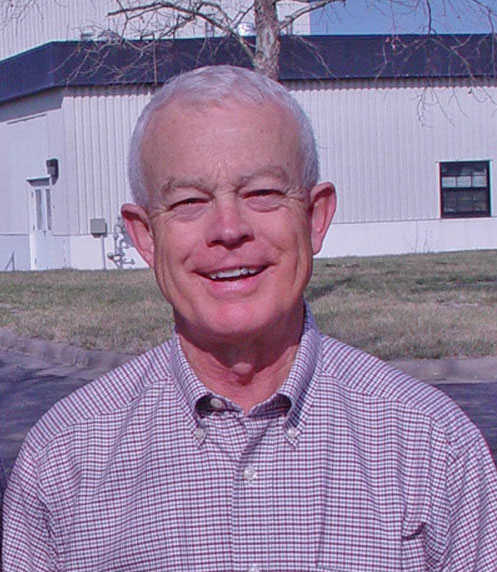 Dr. Larry Seitz retired on 1 April,
2006, after nearly 34 years of service with the USDAARS Grain
Marketing and Production Research Center as a Research Chemist
in the Grain Quality and Structure Research Unit, Manhattan, KS.
Dr. Seitz received his B.S. degree in Chemistry from Kansas State
University in 1962 and his Ph.D. in Chemistry from the University
of Illinois in 1966. From 1966 to 1972, he was Assistant Professor
in the Department of Chemistry and Teaching Associate in the Department
of Biochemistry at Kansas State University. On 9 July, 1972,
Dr. Seitz began his career with the USDA.
Dr. Larry Seitz retired on 1 April,
2006, after nearly 34 years of service with the USDAARS Grain
Marketing and Production Research Center as a Research Chemist
in the Grain Quality and Structure Research Unit, Manhattan, KS.
Dr. Seitz received his B.S. degree in Chemistry from Kansas State
University in 1962 and his Ph.D. in Chemistry from the University
of Illinois in 1966. From 1966 to 1972, he was Assistant Professor
in the Department of Chemistry and Teaching Associate in the Department
of Biochemistry at Kansas State University. On 9 July, 1972,
Dr. Seitz began his career with the USDA.
Dr. Seitz is an adjunct professor in the Department of Grain Science and Industry and a member of the Graduate Faculty at Kansas State University. He served on the editorial board of AACC International as Associate Editor of Cereal Chemistry (198084). He was a member of the Mycotoxin Technical Committee of AACC International during his entire career in ARS. He served as Secretary (188485), Vice Chairman (198586), and Chairman (198787) of the Regional Committee NC-213 (Formally NC-151), "Market and Delivery of Quality Cereals and Oilseeds".
In general, Dr. Seitz's research focused on the application of chemistry for determining the quality of grain in the commercial trade and/or being used for production of feeds and foods. He has considerable experience with chromatography and spectroscopy techniques needed to separate and identify chemical compounds in raw grains and grain-based products.
Dr. Seitz has been involved in a number of different projects during the course of his career. He started his career by developing and testing methods for determination of aflatoxin in grains, which soon lead to research on other mold metabolites. He was the first to identify metabolites of the mold Alternaria in grain sorghum and was involved in several investigations on toxicity and production of those metabolites in sorghum and rice. He developed the ergosterol assay for measuring total fungal invasion in grains which is now accepted worldwide and applied to many other biological systems besides grains.
Dr. Seitz identified relationships between fungal growth, grain respiration, and dry matter loss during storage of corn. In response to a widespread scab infestation in wheat in Kansas and other states in 1982, he investigated effects of scab on distributions of the mycotoxin deoxynivalenol among fractions from the cleaning and milling of hard and soft wheats. At the request of GIPSA-Federal Grain Inspection Service, Dr. Seitz developed methodology for determining volatile compounds in grains and identified relationships between volatile compounds and off-odors in corn, wheat, sorghum, and soybeans. In addition, numerous volatile compounds from molds, insects, and various foods, especially breads, were identified. The Grain Odor Project also involved evaluation of several electronic-nose instruments for potential to aid grain inspectors classify odors in grain samples being graded. In other research, various low-volatile components in wheat, corn, and sorghum were investigated, which included the identification of 2-oxo-resorcinols in wheat and several stanyl ferulates in corn and wheat. Subsequent research by others showed that the ferulate compounds have significant nutritional benefits in grain-based foods.
Dr. Seitz found compositional differences concerning red and white wheats and collaborated with other researchers in the development of methodology for color classification of wheat samples. In his latest research, Dr. Seitz has focused on determination of flavonoid compounds in sorghum grain that relate to seed color, damage by molds and insects, and possible antioxidant-related nutritional benefits in sorghum-based foods.
Dr. Seitz has authored or co-authored 80 peer reviewed journal papers, including 4 book chapters. He has made 47 invited presentations and published 60 abstracts. He is a member of AACC International, Gamma Sigma Delta (Honor Society of Agriculture), American Association for Advancement of Science, and the American Chemical Society. He was invited to speak on the topic "Fungal Metabolites and Growth in Solid Substrate Fermentations" at the Gordon Research Conference on Fungal Metabolites: Biogenesis and Function, Plymouth, NH, 1978.
Dr. Seitz was invited to establish the ergosterol assay for measurement of mold invasion in grains at the International Crops Research Institute for the Semi- Arid Tropics in India, 1986. Dr. Seitz was also honored by the International Commission on Food Mycology and asked to present lectures on the development and applications of the ergosterol method for measuring mold contamination in grains and foods and the determinations of volatile compounds and odors in grains and foods at Uppsala, Sweden, 1998.